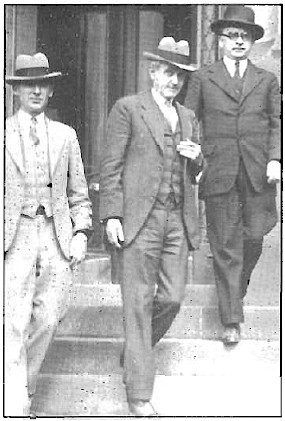A Man, His Scrapbook, and the Marshals Service
When retired Chief Deputy Patrick J. Pyne of the District of Rhode Island passed away in 1983 at the age of 93, he left behind a personal scrapbook which is a treasure trove of Marshals Service history and an insight into the man he was.

From the time of his initial appointment as a Deputy U.S. Marshal in 1918 until his retirement in 1959, Pat maintained a record of his work which reflects the evolution of the Marshals Service in the 20th century. It has been made available by his granddaughter.
One of Pat's duties was to give the formal cry at opening sessions of federal court, and he did so with great solemnity attired in a blue and gold uniform coat. He assumed the duty in 1921 when Deputy John Haven was killed in an automobile accident on his way to serve a summons in Newport. He carried on the tradition through his final day on the job.
But Pat was involved in a wide range of duties. Ratification of the Volstead Act thrust U.S. Marshals into the forefront of enforcing prohibition. On one occasion he pursued a moonshiner over fences and through yards and fields before capturing him at gunpoint in a country store.
He escorted prisoners to the Providence County Jail on the Riverpoint trolley car and made the trip to the US. Penitentiary in Atlanta some 40 times.
Included in the scrapbook are pictures of Chief Deputy Pyne escorting convicted racketeers from the U.S. Courthouse in Providence; providing security for the late U.S. Senator Estes Kefauver (D-Tenn.); receiving an award from the late U.S. Attorney General J. Howard McCrath, a native Rhode Islander; and chatting with the late U.S. Senator Theodore Francis Green (D-R.I.), former chairman of the Foreign Relations Committee.
One of his retirement pictures is with a young law clerk, Bruce M. Selya, who today is a U.S. District Court Judge in Rhode Island. There are photos of Pat seizing a ship, opening court, padlocking Oate's Saloon, arresting an individual accused of selling counterfeit ration coupons during World War 11, and escorting executives of jewelry firms to arraignment on charges they filed false affidavits with selective service boards.
A clipping details Pat's efforts to seize the America's Cup Defender, Columbia. At a time when deputies had no tenure, Pat served under eight U.S. Marshals. An attempt to remove him in 1933 was thwarted by Judge Ira Lloyd Letts.
A Democrat, Pat survived during terms of three Republican presidents. When President Franklin Delano Roosevelt chose William F. Goucher to be U.S. Marshal, the new appointee dismissed Pat. Judge Letts refused to sign the payroll unless Pat was rehired. While Pat went off to the New York-Washington World Series, Marshal Goucher quietly reinstated him. Judge Letts then signed the payroll.
The era in which Chief Deputy Pyne served was a more slowly paced time, but law enforcement problems were much the same. He dealt with a steady stream of thieves, forgers, counterfeiters, and tax evaders. He took many of them to the half dozen federal prisons then in existence, but most were moved by train. When he arrived at a prison, he notified the Marshal by mail.
Some of his more colorful clients included a Newport man who threatened to blow up the Naval torpedo station to show, his admiration of Hider; Joseph Morelli, described as head of the "Morelli Gang"; James Lavell, "Republican boss of the Blackstone Valley"; a Fall River man convicted of Mann Act violations; and George 'Red" Savage, a reputed racketeer.
At one point in his career, Pat supervised the movement of 127 women inmates to the Federal Correctional Institution in Alderson, West Virginia. They were transported 24 at a time in railroad cars. On more than one occasion, Pat was ordered out into the street to summon citizens at random for jury duty.
Many of the clippings are personal and provide insight into Pat's life outside the Marshals Service. Fiercely proud of his Irish heritage, he was active with the Eire Society and the Friendly Sons of St. Patrick. There are numerous pictures and stories of those organization's activities and Pat's participation.
Given equal billing are stories about family births, marriages, and deaths. There are few Marshals Service personnel who knew Pat Pyne personally. For most, he is but part of the long history of U.S. Marshals. In the days before teletypes, photo copiers, NCIC, EPIC, the Witness Security Program, or Special Operations Group, he carried out his varied duties as a Chief Deputy. It is on his legacy that the US. Marshals Service has been built.
His scrapbook provides a concise picture of the service he gave so willingly to his country, a reflection of U.S. Marshals Service development, and a reminder of this complete man who set an example in both his and personal life.
Pat Pyne left much for all to reflect upon and in his quiet way taught us all some valuable lessons. He was a true law enforcement pioneer and lives on as a legend of the Marshals Service in Rhode Island.
by Former U.S. Marshal Donald W. Wyatt, January 1983

